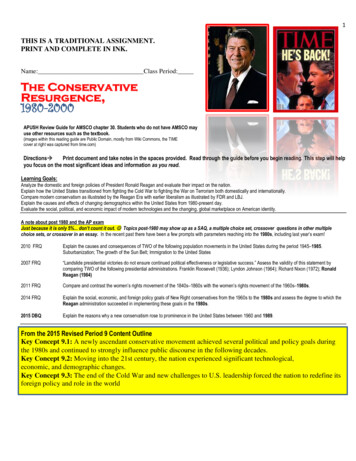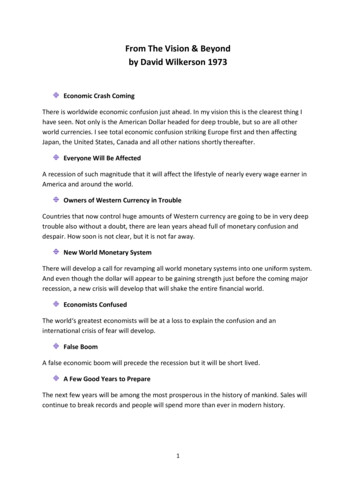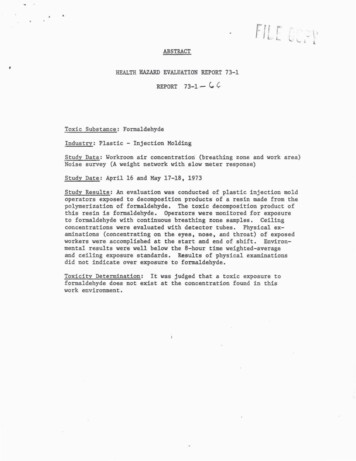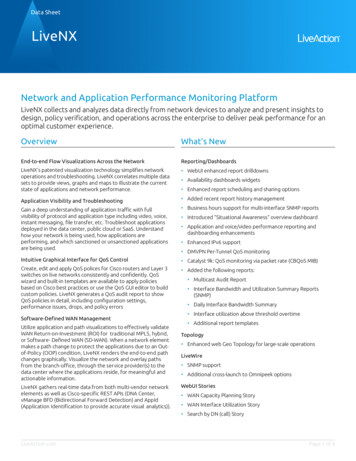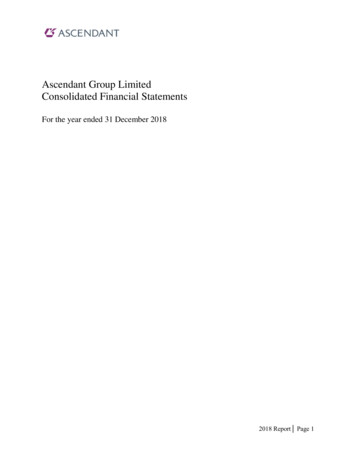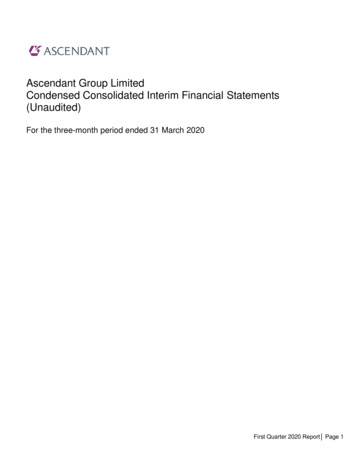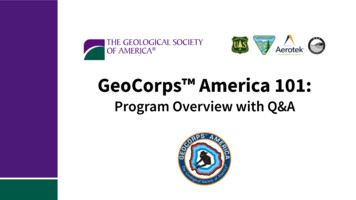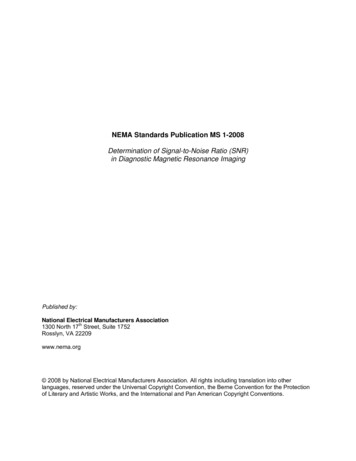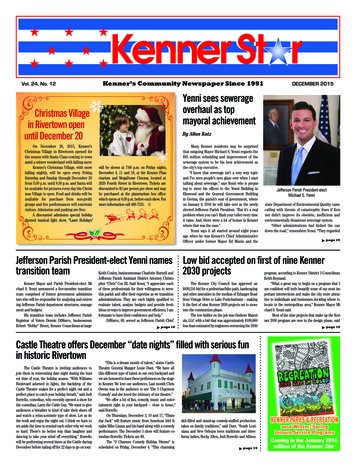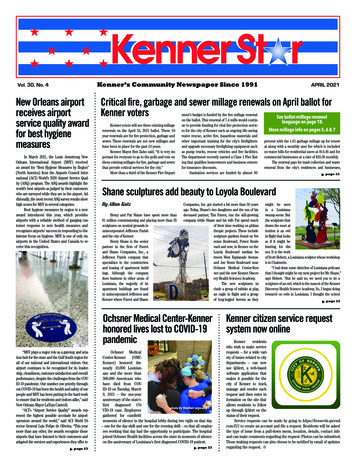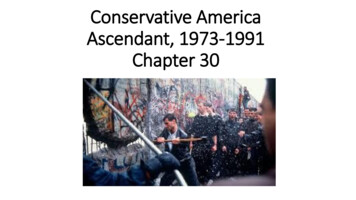
Transcription
Conservative AmericaAscendant, 1973-1991Chapter 30
The Rise of the New RightBarry Goldwater and Ronald Reagan: Champions of the Right Ronald Reagan (from CA) joined the Republican Party in the early 1960s as aspeaker for candidates such as 1964 Republican Presidential nominee BarryGoldwaterThe Conscience of a Conservative Like Reagan, Goldwater came from the Sunbelt (AZ) His book The Conscience of a Conservative set the foundation of the newRepublican Party Criticized the New Deal as “absolutism” and criticized “containment” as being tootimid
Grassroots Conservatives Because moderates controlled the Republican Party, winning the 1964 nomination for Goldwaterrequired conservatives to build from the bottom up. Much support came from the Sunbelt: Orange County, CA, fast growing suburbs of Phoenix,Dallas, Houston, Atlanta, and other cities Phyllis Schlafly was a huge supporter of more aggressive conservatism in the Republican Party. Equal Rights Amendment opponent (Chapter 29) Accused Republicans of being Democrats in disguise Goldwater’s militant tone and Lyndon Johnson’s dedication to continue liberalism after Kennedy’sassassination was too much for him to even compete. However, much support grew in favor of Ronald Reagan as a candidate for the future
Free-Market Economics and Religious Conservatism Conservatives ideological positions were: anti-communism, free-market economics, and religiousmoralism William Buckley founder and editor of the National Review, used his magazine to criticize liberalpolicy Economist Milton Friedman promoted free market ideology Conservative Christians used politics and Republican Right to condemn: divorce, abortion,premarital sex, and feminism Charismatic televangelists Pat Robertson and Jerry Falwell emerged as champions of amorality-based political agenda during the late 1970s A succession of conservative organizations would emerge in the 1980s A series of events that undermined support for the liberal agenda of the Democratic Party: thefailed war in Vietnam; a judiciary that legalized abortion and pornography, enforced schoolsbusing, and curtailed public expression of religion; urban riots; and stagnating economy
The Carter Presidential Interregnum Jimmy Carter’s unsuccessful presidency opened the door for Reagan’s election Human Rights in the State Department Withdrew economic and military aide from some oppressive regimes(Argentina, Uruguay, and Ethiopia) 1977 he signed a treaty to turn over the Panama Canal to Panama (December 31,1999) Bad negotiations with Soviet president because of Soviet’s human rightsviolations SALT II Covert support for Mujahidin inSoviet-Afghanistan conflict in 1978
Hostage Crisis Carter’s ultimate undoing came in Iran Since the 1940s the U.S. supported Mohammad Reza Shah Pahlavi, ruler of Iran Assistance from CIA His crimes using secret police were overlooked by U.S. In 1979, a revolution drove the shah into exile and he was replaced by popularfundamentalist Ayatollah Ruhollah Khomeini The U.S. admitted Shah Pahlavi into the U.S. for cancer treatment Result Carter refused to negotiate Iraq’s invasion on Iraq lead Khomeini to negotiate and focus his attention on the invasion November 1980 the hostages were finally released the day after Carter left office
The Election of 1980 President ’s Carter’s ratings dropped to a historical low Economy Weak response to Soviet expansion Iran Hostage Crisis Ronald Reagan campaigned against liberal policies Against affirmative action, and forced busing With Reagan victory, Republicans controlled the senate
The Dawning of the Conservative AgeThe Reagan Coalition The core of the Republican Party remained: affluent, white, Protestant voters who supportedbalanced budgets, opposed government activism, feared crime and communism, and believed instrong national defense Suburban traditions of racial homogeneity, combined with the middle class comfort more inclinedto support conservative public policies He attractive southern whites who were against civil rights. He validated 25 years of southernopposition to federal civil rights legislation The Religious Right were crucial to Republican victory Against abortion, called for voluntary prayer in schools, and mandatory death penalty forcertain crimes Blue collar Catholics alarmed with antiwar protests and rising welfare expenditures and hostile tofeminist demands supported Reagan
Conservatives in PowerReaganomics Was a theory of underlying supply-side economics Reduce taxes of corporations and wealthy Americans, who could use the savings toexpand production and create jobs Tax cuts now would create tax revenues later Economic Recovery Tax Act (ERTA) For most Americans for 3 years Estate taxes and inheritances Corporations Could not cut New Deal policies Not based on economics, based on faith Military spending of Cold War created the biggest national debts since the GreatDepression Rising deficit of the 1980s contradicted Reagan’s pledge of fiscal conservatism
Deregulation President Carter began deregulation in the 1970s but Reagan expanded themandate to include cutting back on government protection of consumers,workers, and the environment EPA (Environmental Protection Agency) and OSHA (Occupational Safety andHealth Administration) were undermined during the Reagan administration Companies saved costs by refusing to clean up toxic waste and adhere tosafety regulations The Sierra Club, however aroused enough public outrage to change theadministrations position in the late 80sRemaking the Judiciary Reagan attempted to make the Supreme Court more conservative by 3appointments. However, only one was truly conservative. Limited reach of court ordered busing, and endorsing constitutionalprotection of property rights Did not overturn the liberal rulings of the Warren and Burger courts(abortion, affirmative action, and rights of criminal defendants)
AIDS In the 80s AIDS killed nearly 100,000 people. However, early victims were gaymen, thus Reagan, emboldened by New Right conservatives, hesitated indeclaring a national health emergency In Reagan’s last years of office federal resources began to finally devote attentionto treatment for HIV and AIDs patients and research. But the delay had proved costly, inhumane, and embarrassingMorning in America Unemployment in 1981-1982 neared 10%, the highest rate since the GreatDepression Combined with booming deficit, forced Reagan to negotiate a tax increase withCongress in 1982
Election of 1984 Reagan’s remarkable ability to produce positive associations and feelings,alongside robust economic growth after the 1981-1982 recession, helped makethe 1980s decade characterized by both backward-looking nostalgia andaggressive capitalismReturn to Prosperity By 1985 the U.S. imported more goods than it exported Heavy trade with japan Decline in productivity Economy grew because of financial services, medical services, computertechnology- the service industry
Culture of Success Late 80s was popularized by the free market capitalist millionaires benefitingfrom Reaganomics Lee Iacoca, Donald Trump, and Ivan Boesky were money celebritiesThe Computer Revolution Bill Gates, Paul Allen, Steve Jobs, and Steve Wozniak were four entrepreneurswho pioneered the computer revolution in the late 1970s and 1980s They made the computer accessible to individual consumers IBM was the first personal computer in 1981 Apple Corporation’s Macintosh computer became thefirst run-away commercial success for a personal computer Gates and Allen founded Microsoft who soondominated the software industry
The End of the Cold WarU.S.-Soviet Relations in a New Era Reagan inherited a decade of détente that produced a relaxed tension with theCommunist world.Reagan’s Cold War Revival Reagan administration had a new strategy Abandon détente and rearm America Fund anticommunist movements in Angola, Mozambique, Afghanistan, and CentralAmerica Supported repressive corrupt right-wing regimes in Guatemala, Nicaragua, and ElSalvador that ruled by military dictatorships that murdered, kidnapped, and torturedthousands of citizens It blocked Soviet influence but also damaged local communities and the internationalreputation of the U.S, as it did in the Vietnam war
Iran-Contra Reagan considered Iran an “outlaw state” and supporter of terrorism However, he wanted Iran’s assistance in a hostage situation against Hezbollah, a pro-Iranian groupin Lebanon To get Iran’s help, Reagan authorized the selling of weapons to Iran without congressional orpublic knowledge. In Nicaragua, the U.S. supported the anti-communist “Contra’s” overthrow of the democraticallyelected Sandinistas (Reagan accused them of threatening U.S. business interests) In 1984 Congress banned all government arms support of the Contras Oliver North, a lieutenant colonel of the Marines, under order of Reagan and high ranking officialsused the profits from Iran deals and illegally assisted the Contras Reagans replied “I don’t remember” when asked if he knew of North’s actions North took the fall and was prosecuted The Iran-Contra scandal weakened Reagan domestically and heproposed no bold domestic policy initiatives in his last two years.
Gorbachev and Soviet Reform Soviet-Afghanistan war in 1979 was just as disastrous as the Vietnam War was for theU.S. Expensive, low military morale, undermined popular support for government Mikhail Gorbachev introduced policies of glasnost (openness) and perestroika (economicreform) Compromise to eliminate all intermediate-range nuclear missiles based in Europe Renewal of détente and lack of Soviet opposition to Eastern bloc dissent Berlin Wall was destroyed in 1989, symbolizing the end of Communism in Eastern Europe Internal conflict in Soviet government and failure of economy were the primary causes ofthe fall of the U.S.S.R. U.S. played and important, but secondary rolein the fall of the Soviet Union U.S. cost 4 trillion, radiation from weapontesting, and anticommunist witch hunts
A New Political Order at Home and Abroad Reagan’s legacy is mixed. His role in facilitating the end of the Cold War is his most importantachievement. His enormous military spending outweighed cuts in other programs He restored popular belief that America could enjoy increasing prosperityElection of 1988 George H. Bush, Reagan’s Vice President selected Indiana Senator, Dan Quayle as his runningmate. Quayle would restore the Christian “family values” vote. Democrat Jessie Jackson became the first AA to challenge for a major party nomination. However, much less charismatic MA governor Michael Dukakis, emerged as the nominee The election confirmed a new pattern that would last through the turn of the21st century. Every 4 years, Americans would have battles between liberals and conservatives
Middle East After Carter’s success negotiating the 1979 Egypt-Israel treaty at Camp David,there were not many bright spots in U.S. Middle Eastern diplomacy. In 1982, the Reagan administration supported Israel’s military occupation todestroy the Palestine Liberation Organization (PLO) Lebanese militants killed 241 U.S. marines in response, and Regan abruptlywithdrew forces
Persian Gulf War In 1980 Reagan supported ruthless dictator of Iraq Saddam Hussein against Iran,in order to maintain supplies of Iraqi oil By 1988 Iran and Iraq signed an armistice In 1990 Hussein quickly conquered neighboring Kuwait to take their oil reservesand threatened Saudi Arabia To preserve Western access to oil, Bush initiated action to push out Iraq’s army The was quick and decisive but Hussein was kept in power
Conservative America Ascendant, 1973-1991 Chapter 30 Author: Marc A. Ramsey Created Date: 4/16/2017 8:59:04 AM
